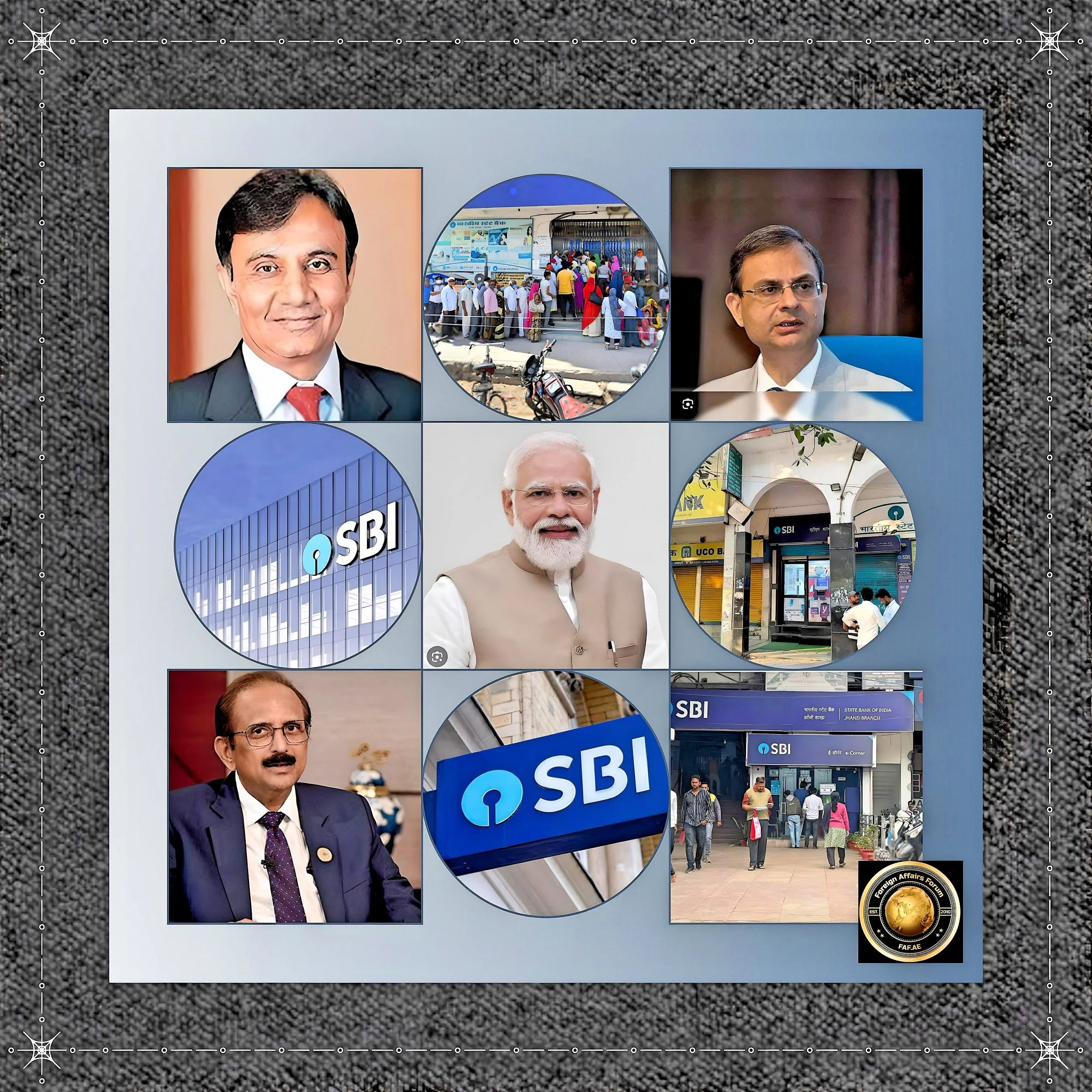Is India a Kleptocracy? SBI case study - Examining Economic Transformation and the Future of Public Sector Banks
Introduction
Since independence, India has undergone remarkable economic transformation, evolving from a primarily agricultural economy to a global player across various sectors.
However, questions persist about governance challenges, including allegations of corruption and the efficiency of public institutions like nationalized banks.
FAF comprehensive analysis examines whether India exhibits characteristics of a kleptocracy, evaluates the performance of public sector banks like SBI, explores the impact on NRI investments, and considers whether privatization offers a viable solution.
Please review the case studies at SBI, West Delhi, India, and the SBI head office at the Delhi India branch.
Understanding Kleptocracy and Its Relevance to India
Kleptocracy, derived from the Greek words “klepto” (theft) and “crazy” (government), refers to a system where leaders abuse political power to enrich themselves using public funds intended for welfare.
The Cambridge Dictionary defines it as a society “whose leaders make themselves rich and powerful by stealing from the rest of the people.” This governance model typically thrives in authoritarian environments characterized by institutional weakness and limited accountability.
Some opposition leaders and critics have employed this term in the Indian context. Congress leader Navjot Singh Sidhu once described Punjab’s governance not as a democracy but as “kleptocracy,” suggesting a system where “there is no welfare of people but only rule of the corrupt.”
The term has also surfaced in national political discourse, with Jairam Ramesh warning that “India’s transition to a kleptocracy will be complete” if regulatory bodies fail to hold powerful business interests accountable.
Key characteristics of kleptocratic systems include unlimited corruption with impunity, a compromised legal system, rent-seeking through preferential contract awards, and media capture to control narratives.
Critics argue that some of these patterns have emerged in specific Indian contexts, citing delays in implementing anti-corruption mechanisms like the Lokpal and selective enforcement of regulations.
Governance Challenges and Institutional Weaknesses
While corruption allegations exist, India maintains functioning democratic institutions, including an independent judiciary, regular elections, and a vibrant civil society that can challenge power abuses.
However, institutional weaknesses remain concerning. The dilution and delayed implementation of the Lokpal Act exemplifies how anti-corruption infrastructure can be undermined.
The relationship between political power and business interests has also raised questions about regulatory independence and enforcement priorities.
India’s Economic Transformation
A Journey of Growth and Reform
India’s economic landscape has transformed dramatically since independence. 1947, agriculture contributed approximately 50% of GDP and employed 70% of the workforce. The country adopted a mixed economy model through the Industrial Policy Resolution 1956, emphasizing public sector primacy in driving industrial development.
Pre-Liberalization Period: Foundations and Challenges
The pre-liberalization era saw significant milestones like the Green Revolution, transforming agricultural production and achieving food self-sufficiency by the late 1970s. Bank nationalization in 1969 (14 major banks) and 1980 (6 additional banks) expanded financial inclusion dramatically, with bank branches increasing from 8,262 in 1969 to 62,000 by 1980.
However, this period was also characterized by the “Hindu rate of growth” – sluggish economic expansion constrained by excessive regulations.
Liberalization and Beyond: Accelerating Growth
The 1991 balance of payments crisis catalyzed comprehensive economic reforms that fundamentally restructured India’s economy.
Post-liberalization, GDP growth accelerated from an average of 3.5% (1950-1980) to over 6% in the 1990s, rising from $275 billion in 1991 to $476 billion by 2000.
The IT sector emerged as a significant growth driver, with exports surging from $565 million in 1991 to $59 billion by 2010.
The past decade (2014-2024) witnessed additional reforms to strengthen the financial sector, simplify regulatory frameworks, and modernize the taxation system through initiatives like GST implementation.
These measures have contributed to India maintaining its position among the world’s fastest-growing major economies.
Public Sector Banks
Performance, Challenges, and Reform Imperatives
Public sector banks (PSBs) have been crucial in promoting financial inclusion and economic development in India.
However, they have faced persistent challenges, including higher non-performing assets (NPAs), operational inefficiencies, and governance issues that raise questions about their long-term viability without structural reforms.
The Evolving Performance Landscape
Recent years have shown significant improvement in PSB financial metrics. The median problem loan ratio improved to 3.96% in March 2023 from 6.47% a year earlier and 14.12% in March 2020.
Similarly, the median return on average assets (ROAA) improved to 0.92% as of March 2023 from negative 0.32% in March 2020. These improvements reflect the benefits of the RBI’s focused “Recognition, Resolution, Recapitalization, and Reform” strategy.
The government has undertaken consolidation to improve PSB competitiveness. In 2020, it merged 10 lenders into four, reducing the total number of PSBs to 12.
This consolidation has generally yielded positive results, with enhanced economies of scale and improved performance metrics.
Regulatory Limitations and Governance Challenges
A fundamental challenge in PSB governance is the RBI’s limited regulatory authority compared to its powers over private banks. Under the Banking Regulation Act, the RBI cannot remove directors and management of PSBs. This regulatory limitation contributed to supervision failures highlighted by incidents like the ₹13,800 crore Punjab National Bank fraud.
The PNB scandal exposed inadequate supervision of employees who misused depositor funds through fraudulent means. Such incidents have raised concerns about PSBs’ risk management systems and accountability mechanisms.
Impact on NRI Investment and Financial Integration
NRIs (Non-Resident Indians) represent a significant potential investment source, but their participation depends heavily on banking system efficiency, regulatory frameworks, and confidence in institutional integrity.
Banking Infrastructure for NRIs
India’s banking system offers specialized accounts for NRIs: Non-Resident External (NRE) accounts for foreign earnings and Non-Resident Ordinary (NRO) accounts for income earned in India.
These accounts serve different purposes – NRE accounts allow full repatriation with tax-free interest, while NRO accounts permit repatriation of up to $1 million annually after taxes.
Interestingly, during global financial crises, Indian banks have sometimes been viewed as safe havens.
During the 2008 financial turmoil, many US-based NRIs transferred funds to Indian banks, with SBI in Gujarat alone collecting over Rs 150 crore in September 2008.
The rupee’s depreciation and attractive interest rates further enhanced the appeal of NRI deposits.
Live case studies on SBI, IDBI, and ICICI Delhi, India
Our Indian correspondent reported a deeply concerning story that deserves our full attention.
A few weeks ago, a 91-year-old client with serious health issues visited the SBI branch on Panka Road, Janak Puri, New Delhi, with a heartfelt objective: to secure fixed deposits and urgently address her stalled pension payments, which have been on hold since November 2019. She truly deserves compassionate support in her time of need.
Upon her arrival, the chief branch manager greeted her warmly, and the staff initially appeared cordial. However, it quickly became evident that the conversation was shifting away from her urgent pension reinstatement. Instead of addressing her pressing concerns, the dialogue turned towards transferring her funds into investment accounts.
At one point, an investment officer and a manager visited her home for verification, but unfortunately, it became clear that no meaningful assistance was provided; the client was misled instead. During the meeting, the manager, an older adult struggling with dementia, seemed distracted and preoccupied with a phone call, which only added to the client's anxiety.
Despite her hopes that they would assist her by adding a name to her account and providing the necessary forms, after spending an hour on a proposal that did not align with her needs, they left without fulfilling their promises. That same day, the client expressed her disinterest in the investment account, but her concerns appeared to be disregarded, leaving her without any receipt or follow-up.
The visiting officer did not follow up or share the manager's name and told the client that the forms had been submitted to the appropriate department, claiming it was no longer her responsibility to check in on it. This was deeply disheartening given the assurances she had received.
Regrettably, the situation only grew more complex when she was sent to the POA office, which then redirected her to the CPOA office. To her dismay, she learned that while the KYC process had been completed in November 2024, the SBI Jwala Heri branch in New Delhi had failed to submit the final request to reinstate her pension. It was disheartening to see that the negligence from SBI Bank was affecting her well-being.
When the client approached the manager at the SBI Jwala Heri branch, she encountered a similarly dismissive attitude. Despite making multiple trips back and forth in search of resolution, she continued to feel unheard and unsupported.
Assurances were made by the chief manager at Jwala Heri that KYC would be handled at her home due to her disabilities, yet no one followed through in the subsequent week.
On her return to the branch, the manager's casual demeanor was disheartening; he did not even offer her a glass of water and instead asked her to wait outside in a crowded area without air conditioning, which must have been quite uncomfortable.
The client felt compelled to comply with the bank's procedures, but it was clear that the manager was more focused on blaming his staff rather than addressing her urgent concerns.
Previously, the client had sought assistance from the former chief manager regarding transferring her accounts between branches, only to be met with rejection.
When the new chief manager at SBI Jwala Heri was approached with the same request, his response, “What do I transfer?” indicated a lack of understanding of her situation, despite the necessary forms being submitted by the previous manager.
The form was simply returned to her, adding to her frustration and sense of being unheard.
Feeling defeated, the client left the branch convinced that her plight regarding the pension reinstatement and account transfer would not be resolved by the chief bank manager.
She even reached out to the SBI Panka Road branch, only to find that the Jawala Heri chief manager seemed unwilling to provide the support she so desperately needed.
This entire experience has understandably left the client hesitant to return to SBI branches, prompting her to elevate our concerns to senior leadership. The pressing question remains: Will her pension be reinstated while she is still alive?
It has truly been an incredibly discouraging experience for her.
On a brighter note, we were relieved when the manager from ICICI and IDBI reached out, assuring us they would help transfer all accounts from SBI to their institution to prevent further issues.
IDBI's manager proved to be invaluable at every stage, ensuring that work was done without delays.
Though both SBI and IDBI are public sector banks, the contrast in service has been striking. Ayush Jain at IDBI extended himself beyond duty to assist, and we sincerely appreciate their proactive approach during this challenging time.
Implementation of Artificial intelligence
State Bank of India (SBI) actively implements AI in customer service to enhance efficiency and customer experience. Key initiatives include:
Agentic AI Deployment
SBI plans to use agentic AI to process requests, suggest solutions, and complete transactions independently, initially for staff and later for customers.
AI Chatbots
SBI has launched chatbots like SIA (SBI Intelligent Assistant) to assist customers with banking tasks and queries, reducing operational costs and improving service quality.
Hybrid Cloud Infrastructure
SBI is adopting a hybrid cloud model to support AI initiatives, ensuring scalability and data security.
Generative AI
The bank uses generative AI for internal efficiency, such as the askSBI chatbot, which aids employees in handling complex scenarios.
Regulatory Barriers and Concerns
Despite these mechanisms, public sector banks' regulatory complexities and service quality issues may deter some NRIs from deeper financial engagement with India.
When NRIs change status from resident to non-resident, they must convert existing accounts to NRE/NRO accounts and update numerous financial records. Non-compliance risks legal issues and operational difficulties.
Customer service quality at PSBs has been a persistent concern. Private banks generally offer more efficient, technology-driven services that appeal to globally mobile NRIs accustomed to international banking standards.
The Privatization Debate
Evaluating Arguments and Evidence
Whether PSBs should be privatized remains contentious, with compelling arguments on both sides supported by empirical evidence.
The Case for Privatization
Proponents argue privatization would enhance efficiency, improve customer service, reduce government financial burden, and create a more competitive banking sector.
Private ownership typically brings stronger profit orientation, more transparent accountability, and faster technology adoption.
The government could redirect funds currently used for recapitalization toward other developmental priorities.
Some experts have proposed privatizing all PSBs except SBI based on performance parameters that favor private sector metrics.
Even SBI’s privatization has been discussed, with some reports suggesting international pressure to make it the first PSB to be privatized.
The Case for Maintaining Public Sector Presence
Opponents counter that PSBs fulfill constitutional objectives and social goals beyond profit maximization.
An RBI paper noted, “While private sector lenders are more efficient in profit maximization, public sector banks have scored better at prom, opting financial inclusion, delivering farm loans and achieving monetary transmission.”
This suggests that PSBs serve policy objectives that private banks might neglect if driven solely by profit considerations.
The RBI has officially maintained an “ownership-neutral” stance on bank privatization.
Governor Shaktikanta Das has emphasized that regulatory focus remains on governance and performance rather than ownership structure.
A Middle Path
Gradual Reform and Partial Privatization
A measured approach may offer the best path forward. The RBI has suggested that “a gradual approach to privatisation could help achieve the broader social objective of financial inclusion”.
This aligns with the government’s stated position of maintaining a public sector banking presence while improving operational efficiency.
Recent reforms have already narrowed the performance gap between public and private sector banks.
Public sector banks’ median net interest margin improved to 3.01% in fiscal 2024 from 2.90% in fiscal 2023, while private sector banks experienced a decline from 4.09% to 3.99%.
This convergence suggests that reform without full privatization can yield significant improvements.
Foreign Institutional Investment
Renewed Interest in Public Sector Enterprises
Despite governance concerns, Foreign Institutional Investors (FIIs) have demonstrated renewed interest in India’s public sector, particularly in well-performing PSUs.
Growing FII Stakes in PSUs
Public Sector Undertakings have experienced a remarkable turnaround, with their market capitalization surging by 231.32% over three years to reach Rs 60,28,419.82 crores.
This resurgence has attracted substantial FII interest, with several PSU stocks recording significant foreign investment.
As of March 2024, Power Grid Corporation led with 29.82% FII holding, followed by REC Ltd (19.91%), NTPC (17.86%), Bharat Electronics (17.56%), and Power Finance Corporation (17.19%).
Thirty out of 56 PSU stocks showed increased FII holdings quarter-on-quarter, with Union Bank of India recording the highest increase at 2.78%.
Regulatory Framework for Foreign Investment
The RBI monitors ceilings on FII investments in Indian companies. For most companies, the ceiling is 24% of paid-up capital (though this can be raised), while for public sector banks including SBI, the limit is capped at 20%.
These limitations are designed to maintain domestic control over strategic sectors while still allowing meaningful foreign participation.
The Reserve Bank monitors these investments daily to ensure compliance with established limits. This oversight helps maintain stability while encouraging foreign capital inflows that can enhance liquidity and market efficiency.
Conclusion
Balancing Reform, Governance, and Development
India’s journey from a colonial economy to its current status as one of the world’s fastest-growing major economies represents an extraordinary transformation.
While allegations of corruption and institutional weaknesses exist, characterizing India as a kleptocracy oversimplifies a complex governance landscape with functioning democratic institutions and ongoing reform efforts.
The banking sector, particularly public sector banks, faces challenges that require continued reform.
However, recent performance improvements suggest that consolidation and governance reforms are yielding positive results.
The privatization debate should consider both efficiency gains and social objectives, with a potential middle path of gradual reform and selective privatization emerging as a pragmatic approach.
For NRIs, improving service quality and streamlining regulatory requirements could enhance investment flows.
The renewed FII interest in PSUs indicates growing international confidence in India’s public sector enterprises, suggesting that governance improvements are being recognized by sophisticated global investors, however customer service is lacking at branch level.
We recommend fast inplemeantion of Agnentic AI
Agentic AI at SBI is expected to improve customer satisfaction by offering several key enhancements:
Autonomous Transaction Processing
Agentic AI can process requests independently, recommend solutions, and complete transactions, acting like a digital relationship manager. This reduces wait times and provides faster resolutions to customer queries.
Personalized Interactions
By analyzing customer data, agentic AI can offer personalized and proactive recommendations, enhancing the overall customer experience.
Efficient Issue Resolution
Agentic AI automates workflows and provides instant responses, bridging the gap between customer expectations and actual service delivery times.
Hybrid Cloud Infrastructure
SBI’s integration with Microsoft Azure ensures scalability and robust data protection, supporting these AI initiatives.
Relationship manager
As experienced SBI branches we visited are a choas with no relationship managers like HDFC or ICICI for better service?
Having relationship managers will tremeously help qualified accounts to have less trips to banks, quick access to the RM possibly more efficient on-line banking.
If India’s GDP will hit 3rd ranking globally by 2050, many reforms have to be looked into. A deeper dive is needed to improve customer service and ethical way of doing banking.
As India continues its economic journey, balancing market efficiency with inclusive development remains crucial.
Strengthening institutions, enhancing transparency, and pursuing calibrated reforms will be essential for addressing existing challenges while preserving the social mandates that underpin India’s developmental model.






